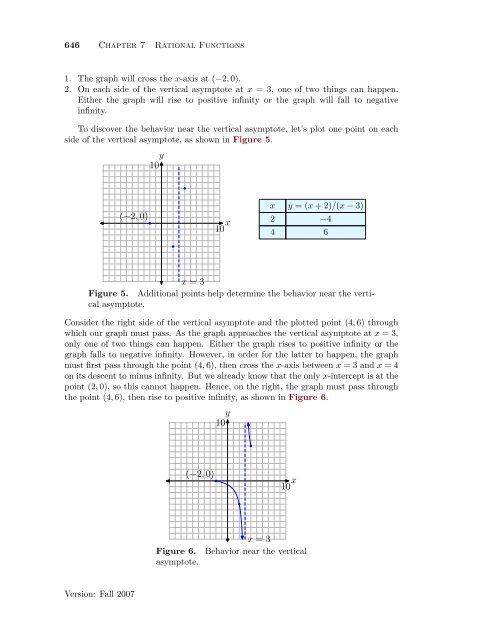Chapter 7 Rational Functions - College of the Redwoods
Chapter 7 Rational Functions - College of the Redwoods
Chapter 7 Rational Functions - College of the Redwoods
You also want an ePaper? Increase the reach of your titles
YUMPU automatically turns print PDFs into web optimized ePapers that Google loves.
646 <strong>Chapter</strong> 7 <strong>Rational</strong> <strong>Functions</strong><br />
1. The graph will cross <strong>the</strong> x-axis at (−2, 0).<br />
2. On each side <strong>of</strong> <strong>the</strong> vertical asymptote at x = 3, one <strong>of</strong> two things can happen.<br />
Ei<strong>the</strong>r <strong>the</strong> graph will rise to positive infinity or <strong>the</strong> graph will fall to negative<br />
infinity.<br />
To discover <strong>the</strong> behavior near <strong>the</strong> vertical asymptote, let’s plot one point on each<br />
side <strong>of</strong> <strong>the</strong> vertical asymptote, as shown in Figure 5.<br />
y<br />
10<br />
(−2, 0)<br />
x<br />
10<br />
x y = (x + 2)/(x − 3)<br />
2 −4<br />
4 6<br />
x = 3<br />
Figure 5. Additional points help determine <strong>the</strong> behavior near <strong>the</strong> vertical<br />
asymptote.<br />
Consider <strong>the</strong> right side <strong>of</strong> <strong>the</strong> vertical asymptote and <strong>the</strong> plotted point (4, 6) through<br />
which our graph must pass. As <strong>the</strong> graph approaches <strong>the</strong> vertical asymptote at x = 3,<br />
only one <strong>of</strong> two things can happen. Ei<strong>the</strong>r <strong>the</strong> graph rises to positive infinity or <strong>the</strong><br />
graph falls to negative infinity. However, in order for <strong>the</strong> latter to happen, <strong>the</strong> graph<br />
must first pass through <strong>the</strong> point (4, 6), <strong>the</strong>n cross <strong>the</strong> x-axis between x = 3 and x = 4<br />
on its descent to minus infinity. But we already know that <strong>the</strong> only x-intercept is at <strong>the</strong><br />
point (2, 0), so this cannot happen. Hence, on <strong>the</strong> right, <strong>the</strong> graph must pass through<br />
<strong>the</strong> point (4, 6), <strong>the</strong>n rise to positive infinity, as shown in Figure 6.<br />
y<br />
10<br />
(−2, 0)<br />
x<br />
10<br />
Figure 6.<br />
asymptote.<br />
x = 3<br />
Behavior near <strong>the</strong> vertical<br />
Version: Fall 2007

















